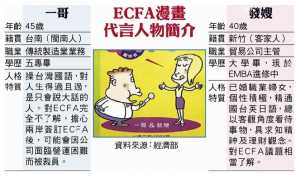Taiwan's Ministry of Economic Affairs published a booklet featuring two cartoon characters to inform the public about the proposed free trade agreement between Taiwan and China, commonly referred to as ECFA. The cartoons quickly attracted criticism [1] as they were considered derogatory to certain ethnic groups. The cartoons depicted two characters, Yi-ge, a Hoklo-speaking salesman from Tainan and Fa Sao, a Hakka woman from Hsinchu who speaks English, Mandarin, Hoklo and Japanese. Yi-ge is depicted as poorly informed about ECFA while Fa Sao is shown as someone who seeks knowledge and is well informed about ECFA.
Echo Taiwan posted a picture [3] of part of the cartoon which described in detail the backgrounds of the two characters. Echo looks at the political reasons why Tainan was represented in this way in the cartoon.
為什麼又必須選「台南人」?台南是前總統陳水扁的故鄉,台南縣市是泛綠到現在還沒有 嘗到選舉敗績的地方,可以說,台南是泛綠支持者的重鎮。把「台南人」跟那些負面的人格描述連在一起,一來讓民眾在閱讀該說帖時,不知不覺在潛意識中被灌輸 「泛綠=低級」的醜化印象,二來又不著痕跡地將阿扁以及阿扁支持者醜化。
The View from Taiwan featured a guest post [4] by Drew Kerslake which analysed the cartoons in terms of their context in contemporary Chinese nationalism. Kerslake argues that both PRC and ROC nationalist ideologies are based on the late 19th century concept of racialism. He goes on to look at how this ideology is reflected in the cartoon characters and the relationship between the coloniser and colonised.
In the case of the cartoon images we see a clear example of Hoklo and Hakka as “ethnic other/periphery”, with the KMT and its representatives firmly in place as the “civilized center” or as “advanced” on a constructed trajectory using the dichotomies of forwardness and backwardness/ advancement and degradation/modern and backward/ civilized and uncivilized .
Kerslake goes on to write that the cartoons are actually discriminatory to both Hakka and Hoklo speaking people in Taiwan.
At first glance the characters are depicted to resemble opposites. Yi-ge the lowly, uneducated, blue collar worker, juxtaposed with Fa Sao, an educated, upwardly mobile Hakka. Although this may be a ploy to score political points with the Hakka, which have gradually shifted support behind DPP candidates, the cartoon depictions serve to degrade both Hakka and Hoklo speakers to the fetishized objects of colonial desire.
The Far-Eastern Sweet Potato writes that the production of the cartoon [5] wasn't a mistake and someone high up should take responsibility.
Deng can say all he wants about the ministry not wanting to insult anyone, but the fact of the matter is, surely, at one point in the process of creating the cartoon, someone in the army of “public relations experts” that came up with this brilliant idea would have noticed that by design or accident, the depictions were prejudicial, if not outright racist. Surely, someone would have raised an objection, or called for caution. If this happened, then that person was silenced, as often happens in government. If no one did, then it means that whoever was involved in the creative process all agreed on what can only be seen as defining characteristics based on biology, which is the first step toward outright racial discrimination.
Letters from Taiwan criticises the apology [6] of Minister of Economic Affairs Yiin Chii-ming (尹啟銘).
Yiin thinks that being born in a place precludes you from ever doing anything that might upset other people from that same place. I can not agree with this premise. Second, Yiin makes a surly, underhand, illdefined attack against ‘people’ who harbour ulterior motives. This comment is a clever way to imply that those who are upset about the cartoons all have ulterior motives (subtext message: if you don't want to be regarded as one of those people, you shouldn't feel so bad about the cartoons). By claiming that it is these ‘people’ who are turning the matter into an ‘ethnic issue’, Yiin not so cleverly hopes that it will distract the public from the origin of the ethnically insulting cartoons themselves eg the Government.
